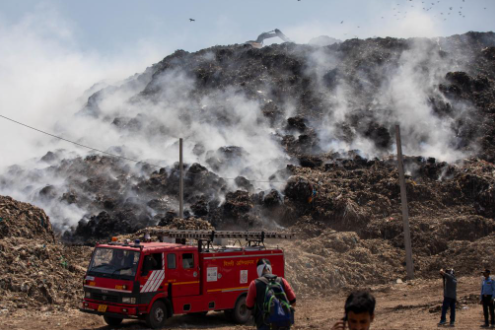Ghazipur landfill: Rising temperatures add fuel to fire concerns (GS Paper 3, Environmental Concern)

Why in news?
- Alarms continue to sound over the Ghazipur landfill site in Delhi after a recent fire outbreak.
- Now, a new study has emerged highlighting the dangers posed by rising temperatures in the region.
What happened here?
- The Ghazipur landfill, notorious for its immense size and environmental impact, caught fire on April 21, 2024.
- The incident blanketed parts of Delhi in toxic smoke, raising health concerns for residents.
What is the effect of increasing temperature?
- Increasing temperatures, a growing threat due to climate change, could exacerbate these dangers, the study has underlined.
- The unregulated nature of the landfill, with its mix of decomposing waste and flammable materials, creates a tinderbox susceptible to spontaneous combustion during hot weather.
- High temperatures in the middle layers of the dumpsite are expanding, moving towards the surface, according to the study published in journal Scientific Reports.
- The composition of the input waste must be carefully decided so that the temperature fluctuations are normalized.
What is the reason behind increase in temperature?
- A municipal solid waste (MSW) dumpsite becomes an “elevated temperature landfill” when it reaches higher temperatures than usual, often exceeding 55 degrees Celsius or 62.7°C.
- Normally, landfills generate heat as waste decomposes. However, when temperatures rise much higher, it's typically due to unusual chemical reactions within the waste.
- These abnormal reactions are the main cause of high temperatures in these landfills, according to the United States Environmental Protection Agency.
- Elevated temperatures in landfills can cause changes in landfill gas composition, noxious odours, rapid and severe waste settlement, leachate seeps and outbreaks.
Municipal Solid Watse (MSW)
- MSW typically comprises waste materials originating from homes, businesses, institutions and industries in urban areas.
- It includes papers, plastics, glasses, metals, food scraps, clothes, yard waste and other miscellaneous waste materials.
Leachate
- Leachate is a contaminated liquid (containing high concentrations of inorganic ions, organic molecules, and other harmful substances, including heavy metals and ammonia).
- The biological decomposition of waste in landfills releases gases, heat, and leachate as a by-product.
- The toxic leachate, according to the paper, can contaminate nearby water bodies or percolate to reach groundwater.
- After taking monthly leachate samples from May 2021 through October 2021, the researchers found that samples were alkaline, indicating an abundance of alkaline compounds.
- The conductivity value, which represents the presence of salts, was also found to be high.
- The team also collected water samples from handpumps and found that water in the wells near the landfill was more alkaline than the distant ones.
- The conductivity of groundwater was high at the north of the landfill and at the points near the landfill.
- The values indicated that the leachate is seeping into the groundwater, the researchers highlighted.
- “The alkaline nature of water and high conductivity values near the landfill suggest a severe risk of groundwater pollution,” the researchers wrote in their study.
Recording temperature
- The team also recorded temperatures at several points in the landfills. Temperature is important to facilitate the biological decomposition of wastes.
- It should ideally be 35°C to 40°C and 50°C to 60°C are the ideal temperature ranges for two kinds of bacteria involved in breaking down garbage, respectively.
- The team also recorded maximum temperatures close to the mid-depths of the landfill.
- The Ghazipur landfill can be accepted as an elevated temperature landfill based on the temperature data obtained.
Zones based on temperature
- The landfill subsoil could be broadly categorised into three zones based on the temperature.
- Zone-1 can be established up to the depth of 30 metres from the surface and has a temperature range of 30-50°C, while Zone-2, which sits between 30 m and 50 m below the surface, witnesses mercury ranging between 60°C and 70 °C.
- Zone-3 extends up to a depth of 60 m and is the coolest, where temperatures stay below 30 °C.
Way Forward
- The Municipal solid waste has dumped unscientifically in unsecure landfill areas in almost all the big cities in India.
- These closed or operational landfills are contributing in greenhouse gas (GHG) emission thus on global warming.
- There is estimate that waste sector contributes approximately 5% to global greenhouse gases emission.
- There is need to initiate mitigation of GHG emission from landfill areas.
- Beside that there is scarcity of land in Indian cities to be used as landfills.
- Thus, mining of valuable resources from old or operational landfill is one of the steps to recycle MSW and also mitigate GHG emission.


